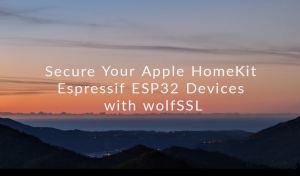At wolfSSL, we have been developing secure boot solutions with customers for many years, and more recently we have released wolfBoot version 1.16, a secure bootloader designed for embedded systems.
wolfBoot provides reliable support to remote firmware updates on a wide range of devices, supporting the most common architectures (ARM TrustZone-M, ARM Cortex-M, ARM Cortex-A, ARM Cortex-R RISC-V RV32, PowerPC, and x86_64 via UEFI).
wolfBoot supports all types of RTOS and embedded operating systems, so it can be used to boot FreeRTOS, Contiki, RIOT-OS, ChibiOS, ThreadX, VxWorks, QNX, TRON/ITRON/uITRON, Micrium’s uC/OS, FreeRTOS, SafeRTOS, Freescale MQX, Nucleus, TinyOS, TI-RTOS, uTasker, embOS, INtime, MbedOS, Linux, and many more…
Here is our list of the top ten interesting facts about secure boot.
- Trusted firmware updates have become a requirement for IoT projects
IoT devices are not immune to cyber attacks, and many real-life cases have proven that misconfigured systems may even be an easier challenge for an attacker, and sometimes even compromise the entire distributed system from a single vulnerability in one software component.
Vulnerabilities happen. No matter whether the software is completely written from scratch or depends on third party components, defects in the implementation may surface at the worst time possible for the project timeline, and critical systems cannot afford to keep vulnerable versions running. At wolfSSL we know that security software development never sleeps. As soon as new vulnerabilities are discovered, the entire team immediately switch their focus on delivering a fix, launch all the tests and release a new version of the software.
IT services may already benefit of continuous deployment mechanisms to ensure that new versions of the software components are available to run just after they have been updated and delivered. This is a good way to reduce risks related to running outdated software in production.
Why should similar mechanisms not be widely available on embedded systems? Well, the question is complicated, due to a few aspects. The diversity of microcontrollers available on the market poses quite a few challenges for embedded systems developers to provide a unified mechanism that fits all the scenarios, use cases, platform specific hardware and sometimes unique communication interfaces and protocols. Moreover, embedded software is generally installed from a monolithic
binary file, containing a 1:1 match to the physical content of the non-volatile memory onboard. Updating a single component may be tricky unless there has been some specific partitioning mechanism in place.
The effort for defining the guidelines for a secure and safe firmware update mechanism have been lead by the SUIT group within IETF, which has studied the problem and has produced a standard RFC9019. “The document […] lists the requirements and describes an architecture for a firmware update mechanisms suitable for IoT devices.”
- Updates are verified using public-key signature authentication
The key feature offered by a secure bootloader following the SUIT definition is the use of state-of-the-art cryptography to guarantee the authenticity of the current firmware and the updates that are coming from a remote source. By using public-key based authentication it is possible to verify that all the software on board before running it.
The mechanism is quite simple: the owner of the device creates a key pair. The private key is secret, it is never revealed or stored on the device itself. The private key is used by a script or a program to sign the manifest header, which is transmitted alongside with the binary image of the new software. The manifest header contains all the meta-data associated to the firmware image.
The bootloader can access a copy of the public key, as it is stored on the non-volatile memory on board, or on a specific hardware secure vault. The public key is not a secret, and even if revealed, it does not pose any risk for the secure boot process.
When the bootloader receives the update package, it uses the public key to initiate the verification. Only software that contains valid metadata, including a verifiable signature, will be allowed to run on the target.
- Operating with small bootloaders
The secure bootloader is, in many cases, the only immutable part of an embedded system. SUIT specifications assume that in general the bootloader itself will not be uploaded because this may pose a risk in reliability. For this reason, one of the requirements for the implementation of a secure bootloader is to keep the bootloader small, and dedicate other components in the system to the task of transferring the firmware images and initiating the update.
This also means that code safety is critical in bootloader context, to guarantee the required level of reliability and minimize the attack surface. SUIT in particular mandates the use of small parsers in the code, since parsers are described as a “known source of bugs”.
One step further in this direction is to completely avoid dynamic memory allocations in the bootloader code. Measuring the memory usage at compile time and allocating static buffers for all the data structures significantly reduce the chance of memory management bugs such as overlapping of sections or heap-stack collisions when inappropriate memory mappings are configured.
A secure bootloader implementation cannot ignore resources and safety related requirements, or the risk is to create bigger issues than what it is expected to fix!
- Rollback attacks
In the perspective of continuous vulnerability management, new updates are released and made available often. Unless the firmware images are transferred using a secure channel, such as TLS, there is always a risk that an old update is intercepted by an attacker, or anyone who is sniffing the traffic towards the firmware consuming device. This is particularly true in those broadcast-friendly environments, e.g. if the firmware images are distributed through a local mesh network that does not support secure socket communication.
An attacker may know about a vulnerability in a previous version, and attempt to downgrade the firmware on the target device to that specific version, by repeating the transmission of the firmware image previously recorded by wiretapping on the network.
A secure boot mechanism must retain the information about the firmware version alongside with all the other information in the manifest header. The version number, like the rest of the meta data, is enclosed in the envelope together with the firmware image during the signing process, which means that the version cannot be altered by an attacker without compromising the validity of the signature for the update package. The bootloader will not allow to install packages with a version number that is older than the one that is currently running on the system.
Rollback attacks are very easy to perform and preventing them is a key task for the secure bootloader.
- Power failures and high reliability
According to Murphy’s law “anything that can go wrong will go wrong”. In the case of remote updates installation, the worst point to lose the power or having any kind of hardware glitch that results in a system reset is when the content of the non-volatile memory is altered during the installation of firmware updates. If a power cut occurs in the middle of a FLASH sector copy operation, the state of the destination sector is unpredictable upon the next boot.
A mechanism that can prevent this situation, like the one implemented in wolfBoot, consists in keeping always two copies of the same sector, and using a mechanism based on flags to confirm that each step has been completed. Upon reboot, the operation can be resumed from the last successful operation, so there is no risk of leaving the system in an unrecoverable state.
- Secure boot and secure update transfers
Downloading the new version is a task for the embedded application, or a thread running on top of a real-time operating system. As indicated by SUIT, including the responsibility of transferring the firmware image in the bootloader code
would result in a bigger, more complex secure bootloader with external dependencies on protocol stack implementations and platform-specific device drivers. Embedded systems may in fact access the network picking from a variety of different connectivity technologies available. Not all of these technologies share the same protocol families or transport mechanisms. Some low power communication protocol such as LPWAN may even have stricter requirements on bandwidth or network availability.
wolfSSL is the embedded SSL/TLS library targeted for embedded systems. Being transport-layer agnostic that can provide secure socket communication on top of all kinds of data transfer technologies and operating system or bare metal applications.
Using the latest standard (TLS 1.3) to secure your connections means that devices can communicate to each other and to the back-end on end-to-end secured channels, using the best cryptography available as standard to date.
Some of the benefits of securing all the data in motion using TLS include of course encryption of all the data transferred between two endpoints, and optionally server-side identification for clients that access data, services or remote firmware updates.
On systems where the entire stack is deployed, including TLS socket communication, transferring the firmware images can be done over the same channel so that the update package can travel the network to the firmware consumer securely.
As TLS may not be an option for a subset of device with a very limited amount of resources available, at least encryption should be considered on such devices. wolfCrypt is a crypto engine targeted for embedded, RTOS and resource constraint environments, which is the core component of wolfSSL, but can as well used as standalone library to access the implementation of the most popular algorithms and cyphers.
- Key management and trust anchors
In a distributed system architecture designed for remote firmware updates, key management is a critical task. The back-end system is in charge of keeping the private key (or keys) safe, and generating signed packages to distribute to firmware consumers when a new version is available.
wolfBoot is distributed with a toolbox of key management scripts and utilities that can be easily integrated on server side to facilitate these tasks. In the simplest case, the signature that is included in update packages is obtained using a private key which is accessible by the owner of the device. In some cases, a more elaborated key provisioning system is in place. When a separate software or hardware component is performing the signature step, the package creation process can be split to redirect and delegate the DSA step to another component.
The public key that is stored inside the embedded system is considered a ‘trust anchor’, because the trust in the validity of the remote firmware updates depends on the integrity of the public key used for digital authentication.
Trust anchor management is in general outside the generic scope of a bootloader itself because it depends on the hardware platform. However, it is of primary importance to include adequate protections against the risk of compromising the public key stored on the device and used by the bootloader to validate the authenticity of the firmware. A trust anchor store should be protected against write access using the available countermeasures available in hardware.
- Secure elements and trust anchor stores
The best way of protecting trust anchors and other cryptographic material is using a hardware component that is designed for this purpose. Hardware security module (HSM, CAAM, etc.) usually offer both key storage and cryptographic operation acceleration in the same module. wolfCrypt, our crypto engine that powers wolfBoot, supports all possible schemes from a wide range of manufacturer-specific API to access this functionality, such as Microchip ATECC608A, ARM CryptoCell, NXP CAU/mmCAU/LTC, STMicroelectronic PKA, Infineon-Cypress PSoC6 and many others. Find the exhaustive list of hardware crypto we support here.
More recently, an effort of agreeing on the protocols used to the access to security cryptoprocessors, ISO/IEC standardized the TPM (Trusted Platform Module) format, which is in use nowadays in nearly all personal computers and notebooks. The same technology is now available for embedded systems thanks to wolfTPM, a library providing APIs to access TPM 2.0 compatible secure element. Popular TPM devices supported by wolfTPM include the ST33 and the Infineon 9670.
wolfBoot can as well be optionally compiled together with wolfTPM to make use of secure key storage and cryptography acceleration provided by these devices. It also support measured boot, storing the firmware hash into a TPM Platform Configuration Register(PCR).
- Updating the bootloader
The SUIT proposed standard recommends that the small bootloader is immutable, due to the intrinsic complexity for the bootloader to implement a reliable way to update itself. However in some cases it is useful to have the possibility to update the bootloader code itself.
Consider for example a situation where the public key is built-in the bootloader code, key provisioning relies on a single private key and this key gets compromised on the back-end.
Another case is a long life product, where the algorithms or the key length in use by the bootloader code today may become obsolete, or compromised, by many years of research. In a few years it may become a requirement to update the bootloader code to match new requirements.
For these reasons we think that giving the possibility to update the bootloader code is important. wolfBoot can be optionally compiled to support this option. A special update package that is marked as wolfboot self-update will cause the bootloader to overwrite its own code after a successful validation of the package itself.
The bootloader update process is not completely fail-safe due to intrinsic hardware constraints, but it is sufficiently reliable to be used for those emergency cases described above.
- Estimating the development effort
When approaching secure boot and remote updates, it is often too easy to underestimate the impact of this single task on the development cycle of the entire project. A large amount of effort is spent on guaranteeing the reliability of the system in all the possible cases that could occur when the device is deployed.
The bootloader is perhaps the most critical part of the system. Everything else in your application can break, as long as there is still a way to update it from a remote location. Implementing a secure bootloader from scratch for a specific project is a tough task which in some cases may require as much development and testing as all the rest of the software components in the system.
At wolfSSL we have several years of experience in supporting our customers to build secure boot and remote updates solutions, and we have designed wolfBoot to provide a solid platform that can be used as the fundamental building block that can fit any secure boot architectural requirements.
We are available to talk with you about your design and we are happy to provide design and development services to complete the integration with any custom embedded system.
We understand how important security is in your IoT project, and we are the only company to offer 24×7 support on secure boot solutions for remote firmware updates.






